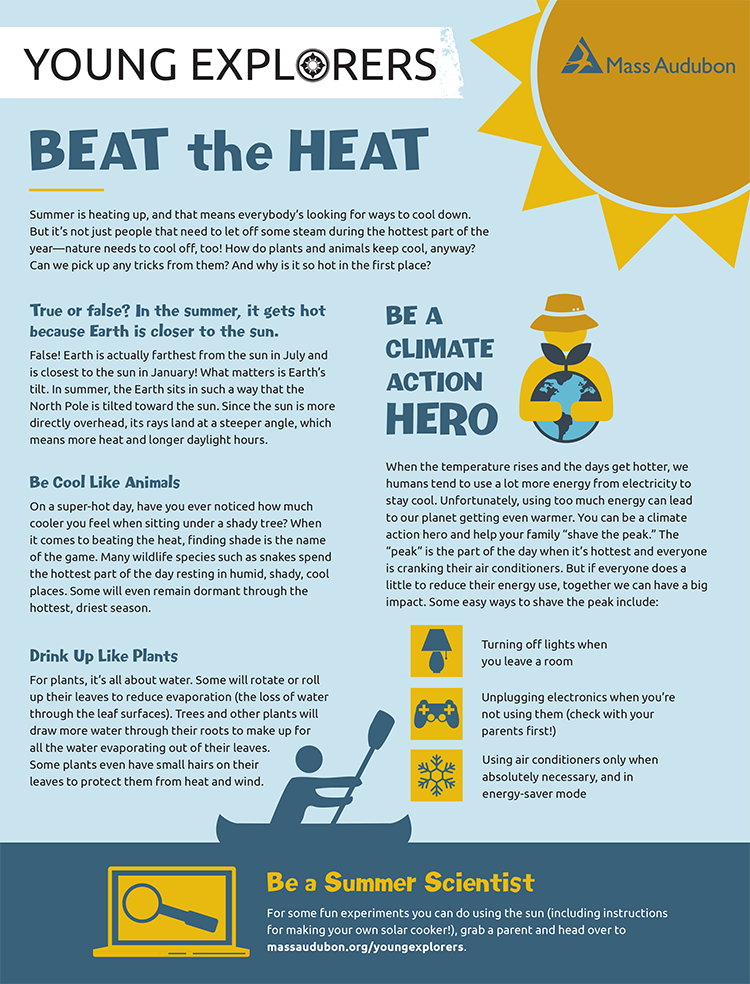Beat the Heat Activity Page
From Explore, Summer 2020
Download & Print
Web Exclusive
Learn more about the sun by trying these three fun experiments—including instructions for making your own solar cooker!
Activity 1: Energy from the Sun
Why do we tend to wear lighter-colored clothing in the summer when it's hot outside? When solar energy from the sun hits an object, some of the energy is reflected and some is absorbed and changed into heat. Some colors absorb more solar energy than others. You can test this!
You'll Need:
- Three thermometers
- One sheet of white paper
- One sheet of black paper
- A sunny day
Instructions:
- Place the three thermometers in a sunny spot.
- Cover the bulb of one thermometer with black paper and cover the bulb of a different on with white paper. Leave the third uncovered.
- Make a prediction—Which thermometer do you think will get the hottest? Which do you think will be the coolest? Make a note of your prediction.
- Wait 5–10 minutes, then record the temperature of all three thermometers.
- How close was your prediction? Are you surprised by the results? What did this experiment teach you?
Activity 2: Heat Absorption
This activity is similar to the first one, but you only need one thermometer, plus some clear drinking glasses or jars and water.
You'll Need:
- 2 identical drinking glasses or jars
- Water
- Thermometer
- 2 rubber bands or tape
- A sheet of white paper
- A sheet of black paper
- A sunny day
Instructions:
- Wrap the white paper around one of the glasses and secure it using a rubber band or tape. Do the same with the black paper and the second glass.
- Fill the glasses with the exact same amount of water.
- Leave the glasses sitting in a spot with direct sunlight for a couple of hours.
- After a few hours, measure the temperature of the water in each glass.
- How close was your prediction? Are you surprised by the results? What did this experiment teach you?
What's Happening Here?
Darker surfaces absorb more energy (light and heat) than light surfaces, so the water in the glass wrapped in black paper should be hotter than the one with white paper, because the light bounces off the white paper and is absorbed and changed into heat by the black paper.
So that's why we don't often wear black-colored clothing in the summer!
Activity 3: Make a Solar Cooker
Have you ever noticed how hot it gets inside a parked car with the windows rolled up in the summer? Sometimes it can feel as hot as an oven! As it turns out, you can use the same science that makes cars heat up to heat your food by building a homemade Solar Cooker. Here’s how!
You'll Need:
- A sunny day
- 1 empty pizza box
- Black construction paper
- Aluminum foil
- Plastic wrap, a sheet of clear plastic laminate, or a heavy-duty, clear 1-gallon freezer bag
- Non-toxic glue
- Tape
- Scissors
- Magic marker
- 1 wooden dowel rod or ruler
Instructions:
- Draw a large square on the top of the pizza box, leaving a little space between the edges of the square and the edges of the box. With help from an adult, carefully cut three sides of the square, leaving one side attached so you can fold the square back.
- Glue a couple of pieces of foil to the inside of the flap you just cut in Step 1 and smooth out any wrinkles as best you can. When the flap is opened, light will reflect off the foil into the box below.
- Open the box and tape a piece of plastic to the underside of the opening you gut in the lid to create a window. Make sure the plastic is tightly sealed around the edges so no air can get in and out.
- Glue more sheets of foil to cover the bottom of the inside of the box, then cover the foil with sheets of black paper, gluing them in place.
- You’re ready to get cooking! Place your food to be cooked inside the box. Close the lid and prop open the window lid using the dowel rod or ruler. Position your oven outside in the sun, so that sunlight passes through the plastic and also so that the foil lid reflects sunlight into the window.
Tips
→ The best time of day to use your solar cooker is between 11:00 am and 3:00 pm, when the sun is most directly overhead and hottest.
→ Try heating up hot dogs or marshmallows for s’mores, or melt some cheese over chips for nachos. You could try toasting a slice of bread or warming up leftovers—use your imagination!
→ To keep the inside of the box clean, make sure to place your food on a plate, pie plate, or small dish.
→ Use an oven thermometer to test your oven temperature. Make a chart and write down how long it takes to reach different temperatures and how long each item takes to cook.
→ Keep the box closed while your food is warming. Opening the box will let all the heat out.
→ See if you can increase the temperature inside the box by "insulating" it, or sealing up the edges where air and heat can escape. You could try rolling up newspaper or kitchen towels and lining the inside edges of the box with them (just make sure you can still close the lid all the way!).
Stay Connected
Don’t miss a beat on all the ways you can get outdoors, celebrate nature, and get involved.




